TurningDieselIntoMemories
My travels into the outback of Australia
Menindee and Kinchega NP
Blog #8 – Menindee & Kinchega NP – Days 39 to 44 of 180
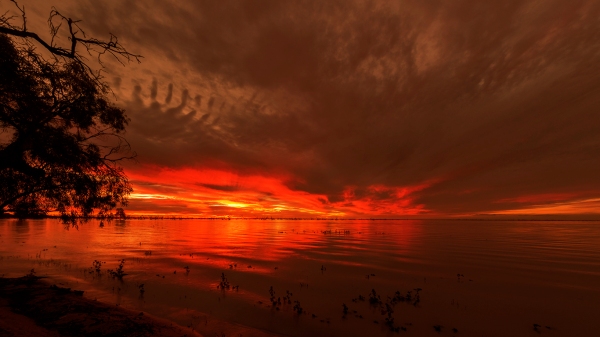
Whilst only 123 klm between these two small outback towns it still took us two hours of teeth rattling and jarred spines of corrugated road to get there with one 10 klm stretch of tar in the middle to give you a false sense of freedom until the dirt (and the corrugations) started again.
We passed the camel man and his entourage 30 klm short of Menindee and gave them a wave on our way through. The local rumours around Pooncarie were that a politician had been to open the floodgates to start refilling the Menindee Lake systems from the waters with promises to keep water in there permanently. This we had to see!!!
Menindee is the oldest township in outback NSW and was founded in 1852 by Thomas Pain. Maidens Hotel is the 2nd oldest pub in NSW (go on Let Google Be Your Friend and look it up!!!) and is still operational today. We had a couple of meals there which weren’t bad for pub grub and the beer was ice cold.

White-browed Treecreeper 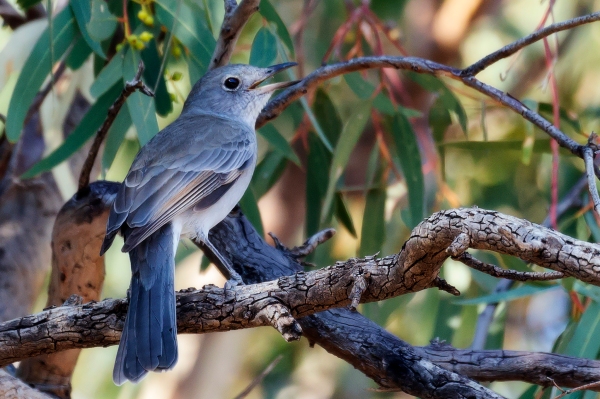
Grey Shrike-thrush Adult Male – another lifer 
Red-backed Kingfisher – another lifer
The Kinchega NP is only about 4 klm south of the township and boasts a variety of places to camp but the one where we wanted to stay (Cawndilla) was closed because there was no water in that lake so we opted to stay at the Darling River campgrounds where there were 34 campsites spread out amongst the trees along the riverbank.

It was a case of first in best dressed along a single lane very dusty road. After driving in about another 3 klm under a cloud of fine dust we opted to turn around and come back out as all the campsites (2 to 34) where under tree cover and a poor opportunity for solar, which we needed, to stay off grid for 5 days. Plus, if it rained it would be a quagmire of clay which would stick to everything. It took us a while to find it but Campsite 1 turned out to be what we needed and had only a short 100 metre dusty road into it plus no other traffic would be driving past the camp day & night coating everything with dust.
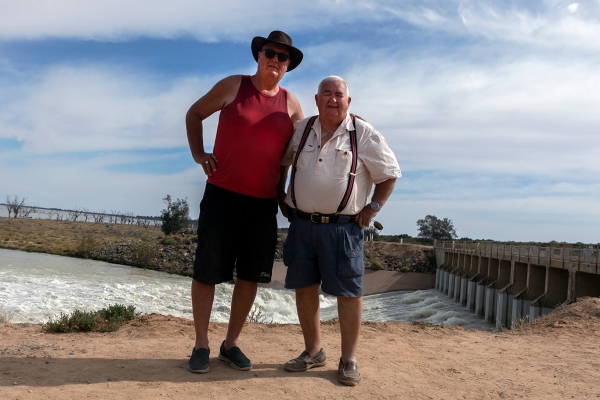
The boys 
Outfall from Copi Hollow 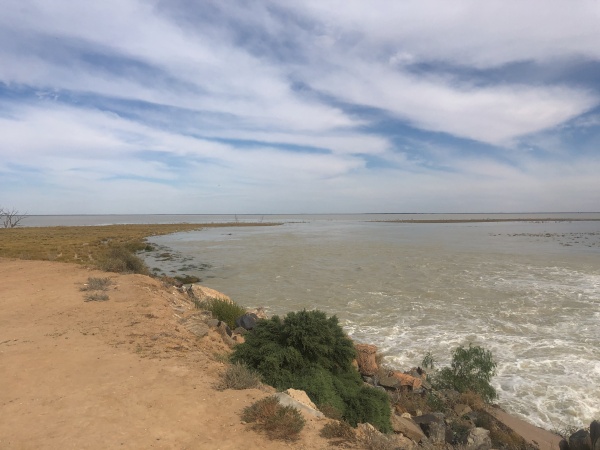
The filling Lake Menindee
Camp setup it was now time to explore. At this stage there was no water near us in Lake Menindee although could see blue water a long way in the distance when we stood on the berm road to the park. One place where could have camped for free was called the Bourke & Wills campsite on the edge of Lake Paramaroo but our research initially had not found it until we had paid our fees. One thing many travelers we had met complained about NSW Parks was that it is almost impossible to change or cancel a booking inside 7 days without substantial fees being applied. If it rained on that campsite road potentially it would become undriveable in very short order nor would you have been able to get to your campsite.
Kinchega NP was part of a vast pastoral lease called Kinchega-Kars and founded in 1870. At its grandest, it covered an area of over 800,000 hectares and stretched from Menindee to Broken Hill, 110 klm away. Over 6 million sheep had been shorn on its boards before operations ceased in the late 1960’s. Kinchega NP was founded in 1967 and it’s 44,000 hectares split from the original lease. The original Kinchega Homestead is now only ruins after a major flood destroyed it in 1956. The last family to work Kinchega, the Bevens family, had built a new homestead closer to the huge shearing shed which was on higher ground. We took a photo showing the flood levels from various years showing how much the Darling River can overflow its banks in the good years.
Herbert Bristow Hughes was one of three brothers who had emigrated from the UK to make their fortune in this new land and setup this vast pastoral lease as an extension of the family holdings in South Australia. However successive land resumptions by the government saw this shrink down to 140,000 hectares by 1958. These resumptions were used to create soldier settlements after the end of the First World War and were a disaster due to farmer inexperience, drought, rabbit plagues and dust storms. But once done there was no turning back. At the end of the Second World War the government, failing to heed the lessons learned by the plague events and droughts of the 1930s & 1940s sub-divided the lands again for intensive pastoralism with devastating results. This is an old land and when the seasons are good it seems it can support huge flocks of sheep but when the droughts set in this becomes a killing land that can no longer support such vast herds nor its native mammals. Records from the droughts in the early 1880s reported up to 47,000 sheep dying and again in 1888 another 45,000 sheep dying on Kinchega holdings alone. The numbers are not as bad in modern times as the flocks were much smaller but the death rates are still high during droughts. Also, in this region of the 88 original mammal species there are now only 27 species left with the others regionally extinct by the 1990s.
Today the town of Menindee has shrunk to a population of 550 and has struggled due to the lack of water since the Darling River ran dry some years ago. I am surprised as the Menindee Lakes/Darling River supplies the town water for Broken Hill with a population near 20,000. It is a wonder that the situation was allowed to get this bad before an act of god replenished the water supply with good rains in Western Queensland & Northern NSW in the last three months. Hopefully the NSW government will better manage the water stocks for the future.
Right off my soapbox and now for some interesting stuff. We travelled along the river road to visit the site where the paddle steamer PS Providence exploded killing all of its crew. The story goes that after a liquid lunch the captain & crew wanting to get a head start on their trip southwards stoked up the fire under the boiler without first filling the boiler with water for sufficient steam for their travels. Some 15 klms south of Menindee the boiler exploded demolishing the ship. It is believed that the bodies of the crew were buried at the Kinchega Homestead cemetery but there are no headstones to support this. All that is left of the paddle steamer is the boiler remnants lying on top of the riverbank.
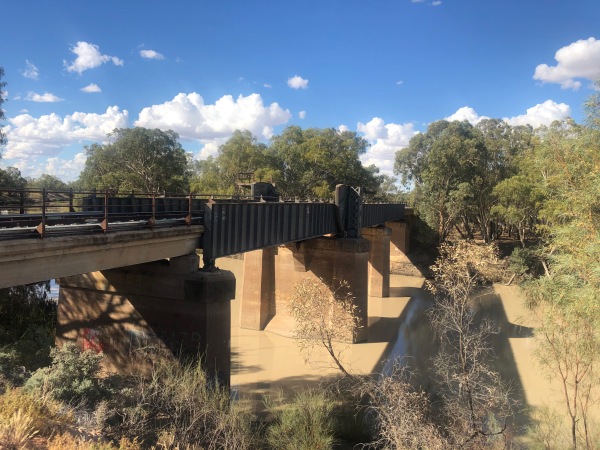
Other places of interest in Menindee are its unique railway bridge which used to be used for both vehicles and trains up until the 1970’s. As bigger levees were built around the lakes and new roads constructed you no longer had to play dodgem with the trains using the same roadway.
After a few days relaxing at our campsite, it was time to go and see what the fuss was about with gorgeous sunsets from the Bourke & Wills campsite on the shores of Lake Paramaroo as it was a bit ordinary where we were camped. Nature turned it on for us and we witnessed one of the best sunsets I have ever seen (see the photos). It will be hard to beat but I am hoping for more special sunsets later in the trip out near Oodnadatta in South Australia.
We went up to see the water roaring into Lake Menindee from Copi Hollow & Lake Paramaroo and it was a pleasure to see the lakes being replenished. Fingers crossed there will be sufficient water influxes to sustain the lakes. It will become a bird haven again given time but at the moment there were only pelicans & cormorants around the lake plus the ubiquitous white-browed treecreeper. I did spot a wedge-tailed eagle but he was too far away for a photo.
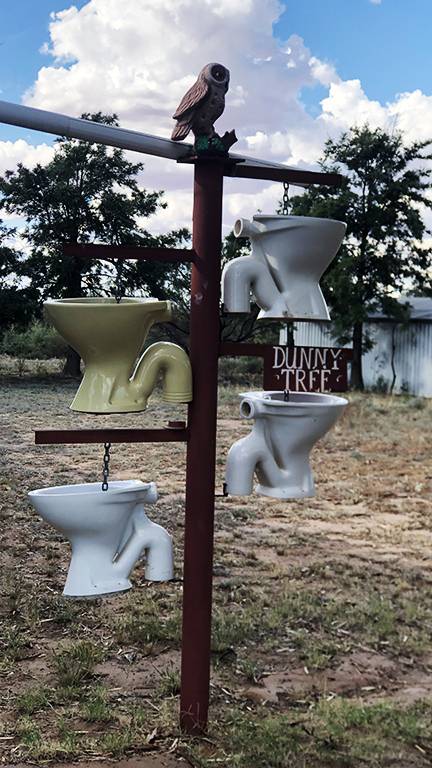
One oddity we found purely by chance is the small village of Sunset Strip. Not to be confused with its famous counterpart in Los Angeles where the American Dream lives large as a place of movie stars & rock stars plus star studded clubs including Whisky-A-GoGo, The Roxy & The Viper Room. Sunset Strip in outback New South Wales is similar, in that it is a where the Outback Australian dream lives large, but unlike its Californian counterpart, it that says nothing about glamour but everything about outback irony and the Australian dream – a holiday house with water views. Most owners would live in Broken Hill and would use these shacks/houses as weekenders. It would have been tough these past few years staring out at a dry lake bed with no fish & no yabbies. It was good to see that aussie humour is alive and well out here as the only thing thriving was the dunny tree!!!
Our last night turned into a bit of misery as it started to rain just after we had dinner in the pub and it was too late to pack by the time we returned to camp. As you can imagine water and clay dust is not a good combination and everything, we walked on was coated with muddy sludge. Eventually we finished packing up and carried out around an extra 50 kgs of mud on the vehicles which get flung off once you reach the tar with a loud thudding noise. So, it was goodbye to Menindee and onto Broken Hill for the next 4 days.
The journey continues………
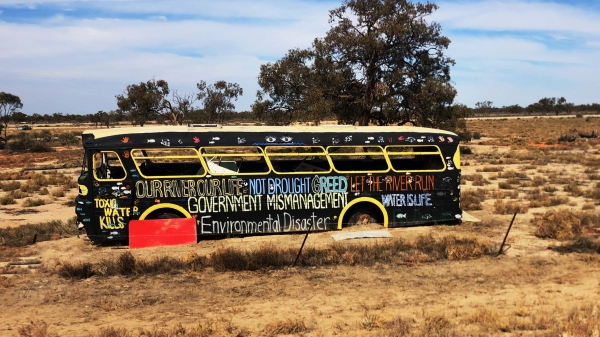

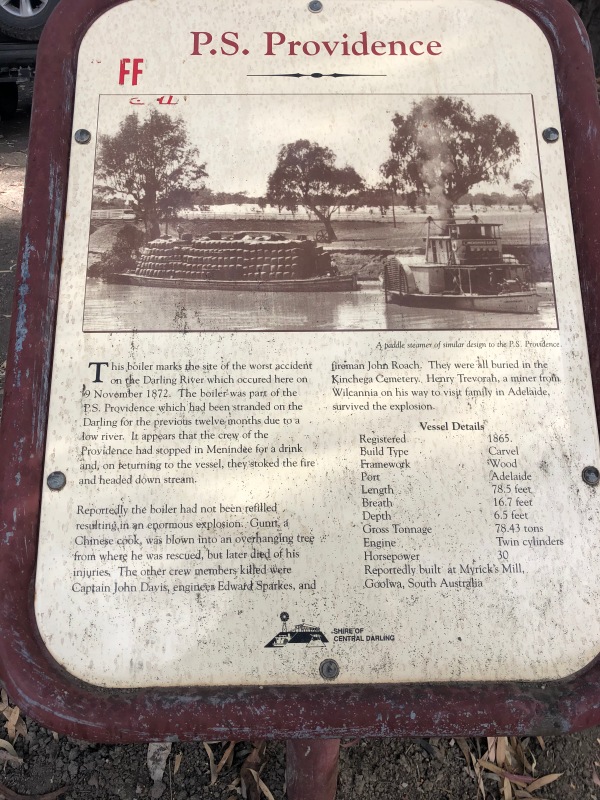

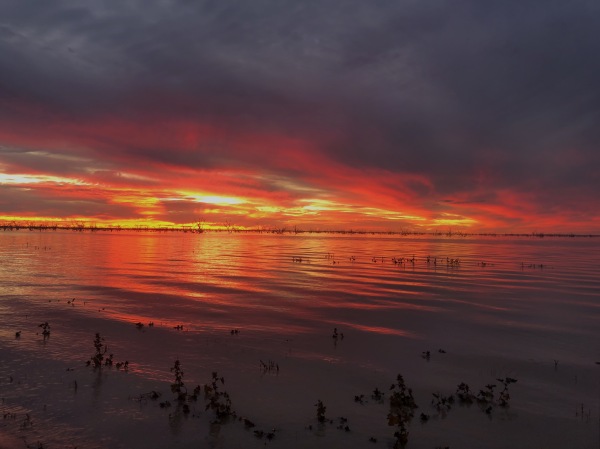

I love reading your great descriptions of places I have never seen nor likely to in my lifetime. I am starting to think you can write an interesting book about your travels with wonderful photographs. I love the photos of sunset, the Dunny Tree ( hilarious) and the beautiful birds you seem to find wherever you go. How I remember the corrugated roads in NT.They were always there wherever you go, Then getting stuck in sand so you have to have spades and strips of metal to help you to drive out. Apart from that please explain why you drive down to Peterborough in South Australia? Is it to get onto a decent road to drive north? I cannot think why else you would drive south. Keep up these wonderful blogs. They are really interesting to all your family and friends. All my love Mum.
LikeLiked by 1 person
Good stuff mate
LikeLiked by 1 person
Fabulous Dave.. Love reading your travel log.. Keep safe, keep enjoying..
LikeLiked by 1 person
Oh wow Wooly, I have just caught up on your last two entries. There is so much history out there, I am so happy about the flood water finally getting down to Menindee lakes. I only hope the NSW government is kept away from it, so it can properly flush out and fill the flood plains properly.
As usual your awesome photos and blog entries are full of interesting facts and sights, I am looking forward to reading about what you do and see in Broken Hill.
P.S. Absolutely love the sunset photos, they look like there’s a fire in the sky.
LikeLiked by 1 person
You sure are in the outback. A good read.
LikeLiked by 1 person